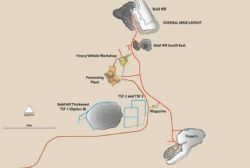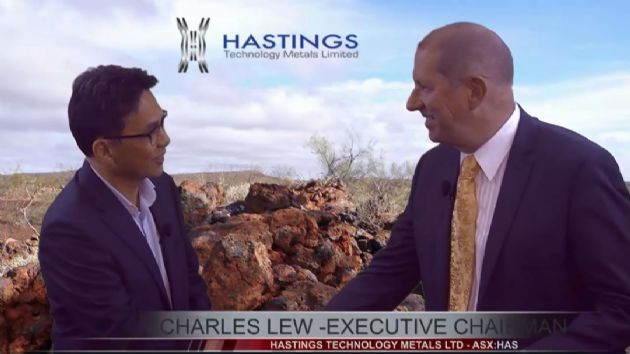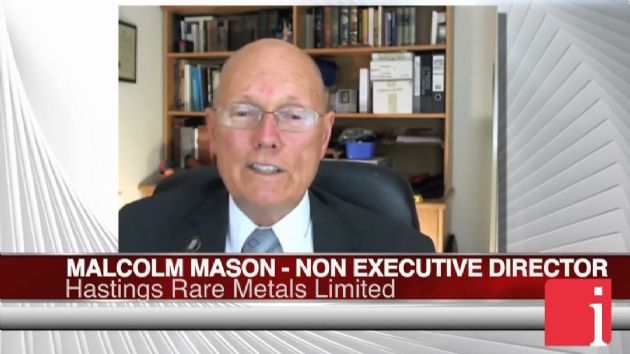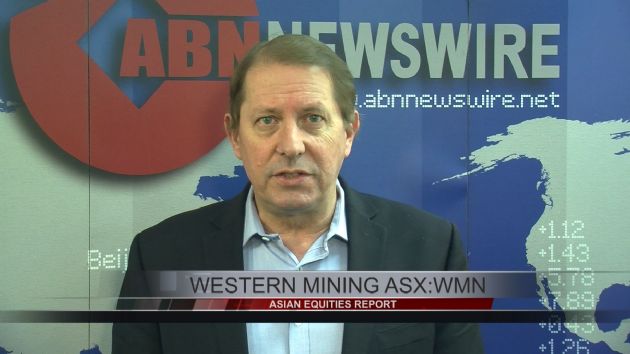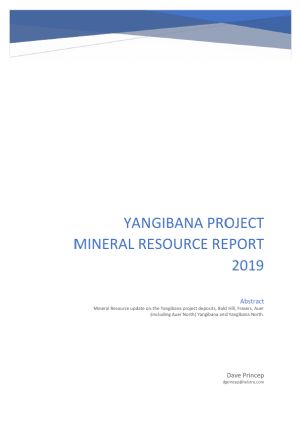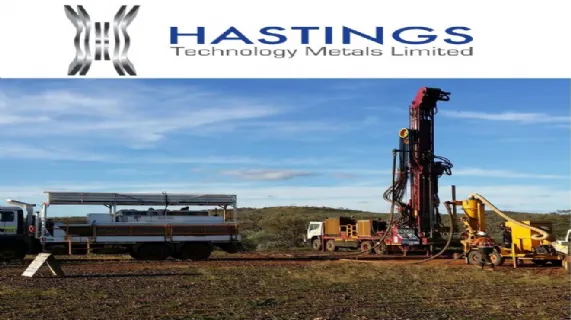
Successful Completion of Yangibana DFS and Executive Summary
Sydney, Nov 28, 2017 AEST (ABN Newswire) - Hastings Technology Metals Limited ( ASX:HAS) (Hastings or the Company) is pleased to announce the release of its Definitive Feasibility Study (DFS) for the Yangibana Rare Earths Project (the Project) in Western Australia. The Project will produce a Mixed Rare Earths Carbonate (MREC) rich in Neodymium (Nd) and Praseodymium (Pr), critical materials used in the manufacture of permanent magnets, which are found in electrical components of many new technology products, from electric vehicles (EV), renewable energy wind turbines and electronic consumer products.
ASX:HAS) (Hastings or the Company) is pleased to announce the release of its Definitive Feasibility Study (DFS) for the Yangibana Rare Earths Project (the Project) in Western Australia. The Project will produce a Mixed Rare Earths Carbonate (MREC) rich in Neodymium (Nd) and Praseodymium (Pr), critical materials used in the manufacture of permanent magnets, which are found in electrical components of many new technology products, from electric vehicles (EV), renewable energy wind turbines and electronic consumer products.
Highlights
- The Yangibana resource (21 million tonnes, JORC Code 2012) will support an initial mine life of 8 years on 100% held ground with further scope to expand production and extend the life of mine
- The Project has an after-tax net present value of A$466 million at a discount rate of 8%, an internal rate of return of 78% and a payback period of 2.3 years
- Probable Reserves (JORC Code 2012) of 5.15 million tonnes on 100% owned ground
- The Yangibana Project has one of the highest known Neodymium (Nd) & Praseodymium (Pr) to TREO Ratios of 41%
- Nd-Pr metallurgical recovery of 75.6% achieved in metallurgical pilot test plant
- Plan to produce up to 15,000 tons per annum of Mixed Rare Earths Carbonate on site in Yangibana
- Pre-production capital expenditure of A$335 million and operating costs of A$17.06/kg TREO (US$12.8/kg)
- Three off take MoUs signed with customers in China representing 40% of production volume
- Native Title Agreement signed for the entire tenement area of 650sqkm covering all rare earths minerals mined and sold
The DFS demonstrates attractive economics using conservative price projections for the key rare earths of Nd-Pr which the company anticipates will have solid demand based on the strong trending growth of EV and wind turbines in particular, as well as other technological innovations. The DFS furthermore demonstrated the technical viability of the Yangibana flow sheet.
The DFS has made significant improvements against the operating cost estimated during the Pre-Feasibility Study (PFS) completed in June 2016, with a total DFS operating cost of A$142 million per annum compared against a PFS operating cost of A$202 million per annum. This represents a reduction of 30% in operating costs from the PFS stage.
The capital expenditure (CAPEX) of A$335 million has improved significantly when compared to the PFS, with the DFS CAPEX now approximately 20% lower than at PFS stage.
The DFS calculations are based on the Maiden JORC Ore Reserves of 5.15 million tonnes at 1.12% Total Rare Earths Oxide (TREO) for the first six years of operations, along with a Production Target for years 7 and 8 based on additional JORC Measured and Indicated Resources. All the Ore Reserves and Mineral Resources included in the DFS lie within tenements owned 100% by Hastings covering an area of approximately 50sqkm out of a total tenement area of 650sqkm.
The Probable Ore Reserves at Bald Hill and Fraser's deposits are based on the JORC Resources shown in Tables 1 and 2 (see link below), that form part of the Total Yangibana Project resources as announced on 22nd November 2017 that total 21.0 million tonnes. Apparent discrepancies might appear due to rounding.
The Modifying Factors used to estimate the Ore Reserves are provided in Table 1 (see link below) Section 4 of the JORC Code (2012).
68% of the initial 8-year operating life underpinned by Ore Reserves.
The Mining focus is high ore recovery and conventional drill and blasting methods will be employed.
The Project is comprised of three main rock types:
- The upper horizon is a saprolite, this does not require blasting.
- The lower weathered and fresh granite horizons require blasting.
- Ironstone (not all of which is ore), RC grade control drilling is required.
The ore dips at between 10 and 45 degrees and varies in thickness between 1m and 20m at Frasers and 1m and 30m at Bald Hill, with an average thickness of 4m. The ore zone (ironstone) is visually distinct from the host rock, providing some control for ore identification.
RC grade control drilling will be done on a 10m x 10m grid, prior to ore delineation.
Selective blasting and mining around the ore zones are designed to remove the hanging-wall as cleanly as possible to expose the ore.
The ore is then mined to the footwall contact using selective mining. Due to the high value of the ore, a high ore recovery is the focus of mining. As such, a 50cm skin of dilution is added to the ore mined to enable a 98% ore recovery assumption.
The ground water at Frasers has a pre-mining static level at 309 metres reduced level (mRL) is 45m below the mining surface and at Bald Hill the pre-mining static level is at 309 mRL and is 45m below the mining surface. Pits will be dewatered ahead of mining using bores to provide a dewatered rock mass at no more than 8 litres per sec pumped from each pit. Stormwater will be managed in pit using sumps and consider pumping up to 10 litres per sec pumped from sumps in each pit.
Waste from each pit is stored in adjacent waste dumps. Some of the Bald Hill pit is backfilled to minimise haulage distances. Ore is transferred either directly to the Run-Of-Mine (ROM) pad, or to a low-grade stockpile, with the mining trucks (as the distance travelled is reasonably low).
Pit optimisations were completed to determine the economic mining limits for each deposit. Only Measured and Indicated Resources were considered for processing. Pits were then designed in stages to enable higher grades to be targeted and waste extraction to be deferred. Both Bald Hill and Frasers are approximately 125m deep. The main Bald Hill pit is approximately 1,100m long and 600m wide. The Frasers pit is approximately 600 m long and 250m wide. The waste dumps are located to minimise haulage distances and were constrained by lease boundaries (Bald Hill) and water courses. The Bald Hill dump covers an area of 100 hectares (ha), and the Frasers dump is 86ha.
The Company has completed extensive metallurgical testwork culminating in pilot plant tests on a composite sample of material from Bald Hill and Fraser's. This testwork has defined a route entailing crush, grind, flotation, acid bake with water leach and precipitation of a Mixed Rare Earths Concentrate. The key parameters are shown in Table 3 (see link below).
All environmental studies and approvals processing are progressing as required. The cut-off grade for the project was determined based on calculating revenue, selling and processing costs on a block-by-block (diluted) basis. Blocks with revenue greater than the sum of the processing and selling costs were considered to be above cut-off.
Based on the resources in Tables 1 and 2 (see link below) and the Modifying Factors, Snowden has estimated the Probable Ore Reserves as shown in Table 4 (see link below).
Financial evaluation provides the outcome as shown in Table 5 (see link below).
The shallow mineralisation at Yangibana is amenable to standard open pit mining consisting of conventional drilling and blasting, operated by mining contractors. The project is designed to bring approximately 1 million tonnes per annum of ore to the Run Of Mine (ROM) pad where the flowsheet process begins. Early stages comprise comminution and beneficiation, resulting in a beneficiated concentrate upgrade by 20 times from the ROM ore, as demonstrated through the DFS, to a 25% TREO concentrate. This concentrate is further processed downstream through a hydrometallurgical process that involves acid bake, water leaching, impurity removal and precipitation to produce up to 15,000 tpa of MREC. The MREC will contain up to 3,400 tpa of neodymium oxide (Nd2O3) + praseodymium oxide (Pr6O11) representing 41% of contained TREO. Hastings will sell this Nd2O3+Pr6O11 rich MREC to rare earths oxides separators or other customers further along the rare earth supply chain.
Mr. Charles Lew, Executive Chairman of Hastings, said, "We are very pleased that the DFS demonstrates the Yangibana project to be economically and technically viable and Hastings is focused on becoming the second source of Nd-Pr supply from Australia. We have already signed three MOUs with Chinese customers and we have ongoing discussions to sell our MREC to customers worldwide."
He continued, "The DFS has gone a long way to de-risk the Yangibana Project. We have importantly demonstrated to our shareholders and customers that we can produce a Nd-Pr rich MREC in Australia, while at the same time gathering important processing data points to proceed to the next stage with the design and development of the Yangibana Project. We will now turn our focus on some early stage infrastructure work, obtaining the remaining permits and approvals and securing the financing to undertake the Project. With the increasing sales of EV, Hastings is well positioned to capture a piece of this massive market where there is a strong demand for permanent magnets to make electric motors."
Recently a number of countries announced policy targets to replace fossil-fuel vehicles with EV over the next decade, and with the innovation in electric motors utilising permanent magnets, the International Energy Agency expects an increase in electric vehicle numbers of between 120 - 200 million by 2030 from 2 million at the end of 2016. Hastings anticipates that these trends will underpin the solid demand for Nd-Pr and its production at Yangibana.
DFS Outcomes
The Project is estimated to generate annual sales revenue of A$379 million, an NPV of A$466 million (discount rate of 8%), an Internal Rate of Return (IRR) of 78% and a 2.3-year payback. These project economics provide a compelling case for an economically viable project.
Revenue streams are highly dependent on Nd-Pr prices - accounting for 85-90% of projected revenue. Together with Dy-Tb, the Nd-Pr-Dy-Tb contribution accounts for 92% of revenue generation.
The Company will continue to work on identifying areas where capital expenditure can be further reduced. Significant gains have been achieved on operating expenses, with a reduction of 30% achieved from the PFS. With estimated annual operating expenses at A$142 million per year, the average operating cost for the project is A$17.0/kg TREO (US$12.8/kg), including all fixed and variable costs.
The DFS financial model assumes an average long-term US$/A$ exchange rate of US$0.75 and price forecasts from 2017 to 2027 for rare earths prices from Argus Media, an independent provider of price information, market data and business intelligence for the global resource industry. Hastings anticipates an increase in some of the key rare earths prices, especially Nd-Pr over the next decade. The price rises seen in 2017 demonstrate that the Chinese authorities are having a degree of success in shutting down illegal production in China and Hastings expects the emphasis on sustainable production to continue in China and be supportive of Nd-Pr prices.
Next Steps
With the conclusion of the DFS, Hastings' management has a number of key focus areas. The company will continue working towards the completion of the remaining permits and approvals, co-ordinating the process by utilising the Lead-Agency Project (LAP) status that the project has been granted by the Western Australian state government. The Yangibana project is not only a high priority for the rare earth and clean energy industries, but also to the local Gascoyne community eagerly anticipating both direct and in-direct work opportunities. Management's objective is to work to ensure a smooth process to commence production by late 2019. Design and procurement activities will also commence in line with the development timeline as outlined in the DFS. Early work on infrastructure and the preparation of the site around Yangibana is expected to commence after the rainy season in March/April 2018.
The company will now focus on the remaining fund raising necessary to complete the project. Hastings is confident that following the release of the DFS, it will be able to secure the required funds to commence construction of the production plant. The Project's economics and financials as reported in the DFS are compelling and strong interest is expected from investors and financiers, given that the rare earth products from Yangibana will be used in renewable and clean energy technologies that have been identified as a strong growth sector. Based in Australia, with a AAA/Aaa sovereign credit rating, high corporate governance and a solid history of successful mining projects, Yangibana offers strategic value to downstream customers in the rare earths supply-chain both in China and outside of China.
Hastings currently has a market capitalisation of approximately A$230m, with A$18m in the bank and no debt. It has a track record of raising A$46m of equity capital since May 2014 and is confident that it will continue to be able to raise the remaining equity capital needed for the Project's capital costs. The company has also undertaken discussions with financial institutions since the completion of the PFS in June 2016, and these discussions will proceed to more formal levels once these institutions have access to the completed DFS. Presently the DFS anticipates a debt-to-equity split of 65%-35%, however this ratio may change depending on advancing negotiations including terms and conditions of loan facilities. Any change in the debt-to-equity ratio may impact the dilution realised by current and future equity investors and will change the overall cost of capital for the Company.
Government agencies in AAA/Aaa sovereign jurisdictions with a mandate to promote renewable and clean energy technologies have indicated interest to provide credit support and/or fund part of the Yangibana Project. Hastings has had discussions with these parties and further progression of these discussions will follow with the release of the DFS.
To view tables and figures, please visit:
http://abnnewswire.net/lnk/8653834K
About Hastings Technology Metals Ltd
 Hastings Technology Metals Ltd (ASX:HAS) (FRA:5AM) is advancing its Yangibana Rare Earths Project in the Upper Gascoyne Region of Western Australia towards production. The proposed beneficiation and hydro metallurgy processing plant will treat rare earths deposits, predominantly monazite, hosting high neodymium and praseodymium contents to produce a mixed rare earths carbonate that will be further refined into individual rare earth oxides at processing plants overseas.
Hastings Technology Metals Ltd (ASX:HAS) (FRA:5AM) is advancing its Yangibana Rare Earths Project in the Upper Gascoyne Region of Western Australia towards production. The proposed beneficiation and hydro metallurgy processing plant will treat rare earths deposits, predominantly monazite, hosting high neodymium and praseodymium contents to produce a mixed rare earths carbonate that will be further refined into individual rare earth oxides at processing plants overseas.
Neodymium and praseodymium are vital components in the manufacture of permanent magnets which is used in a wide and expanding range of advanced and high-tech products including electric vehicles, wind turbines, robotics, medical applications and others. Hastings aims to become the next significant producer of neodymium and praseodymium outside of China.
Hastings holds 100% interest in the most significant deposits within the overall project, and 70% interest in additional deposits that will be developed at a later date, all held under Mining Leases. Numerous prospects have been identified warranting detailed exploration to further extend the life of the project.
Brockman Project
The Brockman deposit, near Halls Creek in Western Australia, contains JORC Indicated and Inferred Mineral Resources, estimated using the guidelines of JORC Code (2012 Edition).
The Company is also progressing a Mining Lease application over the Brockman Rare Earths and Rare Metals Project.
Hastings aims to capitalise on the strong demand for critical rare earths created by the expanding demand for new technology products.
| ||
|



